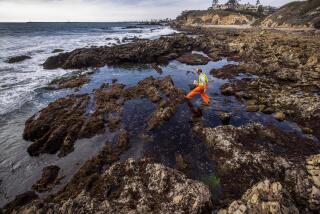Shell’s Arctic oil spill containment vessel plagued by delays
SEATTLE--The vessel designated to act as a crucial oil spill containment system in Arctic waters has obtained Coast Guard approval to meet less rigorous weather standards than originally proposed. But, less than two weeks before drilling off Alaska’s northern coast is due to begin, a series of troubling construction delays have left the Arctic Challenger without federal certification.
The certification issue is the most serious Shell must confront if it is to successfully launch a exploratory drilling program, the first in Arctic waters in two decades, in which it already has invested $4 billion. With a tight weather window before the onset of ice in the fall, Shell engineers had hoped to begin drilling during the first week of August.
But Coast Guard officials said Thursday that several important systems remained to be installed before they could certify the oil spill containment vessel. Sources familiar with the multimillion-dollar refurbishing underway in Bellingham, Wash., said it was clear that the 38-year-old barge would not be ready for sea trials by July 23—a date recently set after a previous schedule was scrapped.
“Construction on the vessel is not complete. Major safety and operational systems are still being installed, tested and certified, and required tests … have not been performed by the shipyard,” Cmdr. C.T. O’Neil, chief of media relations for the Coast Guard, said in a statement.
As of July 17, he said, “major safety systems” such as the primary and emergency power, fire detection and fire extinguishing systems had not been completed. He said inspectors from the Coast Guard and the American Bureau of Shipping remained on hand to conduct reviews once installation was complete.
The Arctic Challenger is scheduled to float between offshore drilling platforms in the Beaufort and Chukchi seas and, in the event of an oil spill that couldn’t otherwise be contained, deploy a large dome that would capture spilled oil from the top of the well, bring it to the surface and pump it into a storage tanker for removal. It also has equipment to flare off natural gas collected from a malfunctioning well.
The U.S. Bureau of Safety and Environmental Enforcement has said it will not issue final drilling permits until the containment system is complete, certified and ready to deploy.
Shell, which has contracted with Superior Energy Marine Technical Services to conduct the reconstruction, did not say Thursday whether the latest delays would affect its drilling schedule. Its timetable had already been set back because of late winter ice in the region.
“It’s certainly taking longer than we hoped,” Shell spokesman Curtis Smith said Thursday. “I can say that we’re not going to rush this. We’re not going to send a vessel that’s not capable. So while it remains a priority and clearly something we need to have done before we commence drilling, we’re not going to cut corners and move quickly where it doesn’t make prudent sense.”
Sources familiar with the construction in Bellingham said four dual anchor winches, one on each corner of the barge, still are inoperable, and the anchors are not installed. Additional work remains on piping, installation of catwalks, electrical wiring and positioning of lifeboats—all theoretically simple, but time-consuming.
In addition, company workers by midweek still had not installed an estimated 200,000 pounds in clump weights, the devices that would anchor the containment dome over the top of an oil spill.
Shell cleared an important hurdle in winning federal approval when the Coast Guard on July 13 accepted the company’s argument that the Arctic Challenger should be certified as a mobile offshore drilling unit, requiring less vigorous weather protection than floating production installations.
In December, Shell had proposed certification under a stricter standard designed for stationary offshore oil platforms. That would have required engineers to prove the Arctic Challenger could withstand the battering of a 100-year storm.
But the company subsequently said it would be more reasonable to consider the vessel to be what it is—a non-stationary barge that can move out of the way when storms approach—and proposed an alternative under which, as a floating installation, Shell would only have to prove it could withstand the winds and waves of a 10-year storm.
“Shell submitted a proposal which further explained the intended operations—describing how the vessel’s mooring system must be agile to allow repositioning during a response to keep the workers on board out of harm’s way—and proposed applying the 10-year storm criteria to the mooring design in lieu of the 100-year standard,” the Coast Guard’s O’Neil said.
He said the 10-year benchmark is “an industry-recognized standard” for mobile offshore drilling units, and the Coast Guard has concurred.
Now, he said, Shell must demonstrate that the Arctic Challenger meets that 10-year standard—which cannot occur until construction is completed.
“That’s what still is to be determined,” he said.
O’Neil said he could not say how serious the remaining issues are.
“Any deficiency or discrepancy is serious, but at the end of the day … if you still have construction ongoing, that’s going to take time to clear, and it’s going to take time to class the vessel. While we’re all working to move this as expeditiously as possible, there’s still a great deal of work to be done.”
ALSO:
Missing Iowa cousins: One set of parents hires attorney
Abduction arrest: Girl says baby brother’s screams saved her
Tennessee Muslims get new mosque, but not in time for Ramadan
More to Read
Sign up for Essential California
The most important California stories and recommendations in your inbox every morning.
You may occasionally receive promotional content from the Los Angeles Times.










